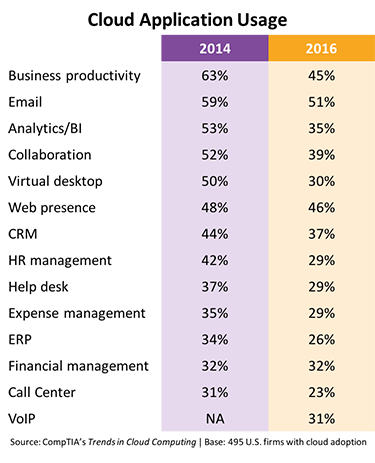 When you’re doing research, it’s great to see data that reinforces trends you’ve identified in the past. Especially with studies that are repeated on a regular basis, there’s hope and expectation that new findings will show steady progress in the themes from earlier years.
When you’re doing research, it’s great to see data that reinforces trends you’ve identified in the past. Especially with studies that are repeated on a regular basis, there’s hope and expectation that new findings will show steady progress in the themes from earlier years.
This wasn’t the case with CompTIA’s new cloud computing research.
At first glance, it appeared that businesses had taken a step back from where they were two years ago. While most companies still placed themselves in the middle two categories of CompTIA’s cloud adoption cycle, there was a shift backwards instead of a shift forward in the numbers. There was a drop in the number of firms indicating secondary migrations between different cloud models. And when it came to SaaS—the most common cloud model—every application listed in the survey saw less cloud usage in 2016 than in 2014.
Since the new survey was mostly unchanged from previous versions, there was little chance that people had been tripped up by deviations in the verbiage. In fact, upon thorough review of the data and side discussions with a few experts, the opposite was true: People are more familiar today with cloud terminology and their responses indicate a deeper understanding of the cloud model and a right-sizing of market reality.
Go back to the applications companies are running in the cloud. According to companies in the 2014 study, analytics/business intelligence was the third most popular cloud application. While it’s true that many companies are pursuing SaaS analytics applications thanks to their availability and accessibility, it seemed a little odd that so many companies would have improved their data practices enough to start using more sophisticated software. Thirty-five percent of companies using cloud analytics/BI seems more reasonable, as do the top three SaaS selections in 2016 – email, Web presence and business productivity.
If companies are beginning to look past cloud-washing techniques and are becoming more familiar with the details of true cloud systems, it makes sense that they would refine their responses around cloud usage. It doesn’t mean that the cloud market overall is shrinking – Gartner still sees double-digit growth in cloud revenue for the next several years – but it does mean that adoption will be more measured as companies transform their IT architecture and business operations.
As with SaaS applications, several aspects of current cloud adoption are relevant even if comparisons to previous data don’t show smooth trending. Companies continue to see many cloud computing benefits, with cost savings becoming a priority again as cloud impacts overall architectures rather than isolated systems. Secondary migrations are still leading to a multi-cloud approach, where monitoring and management will be complex yet critical. And the level of effort needed for cloud transitions remains greatest in the later stages of adoption where businesses are transforming their processes and workflow.
Looking back, maybe we actually did have a sense that the market would hit these bumps in the road. Our previous cloud computing report noted that there was fatigue around discussion about definitions, but it also noted that end-users would show interest in details over the long run. The long run got here pretty quickly, and now conversations must be precise as companies drive their cloud transformation.

